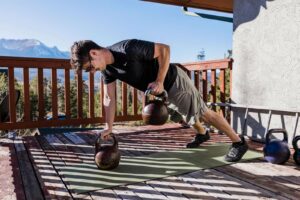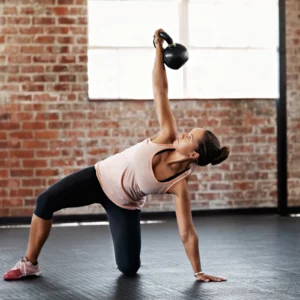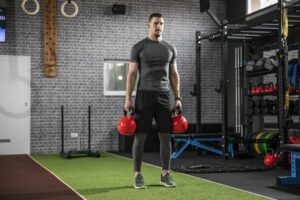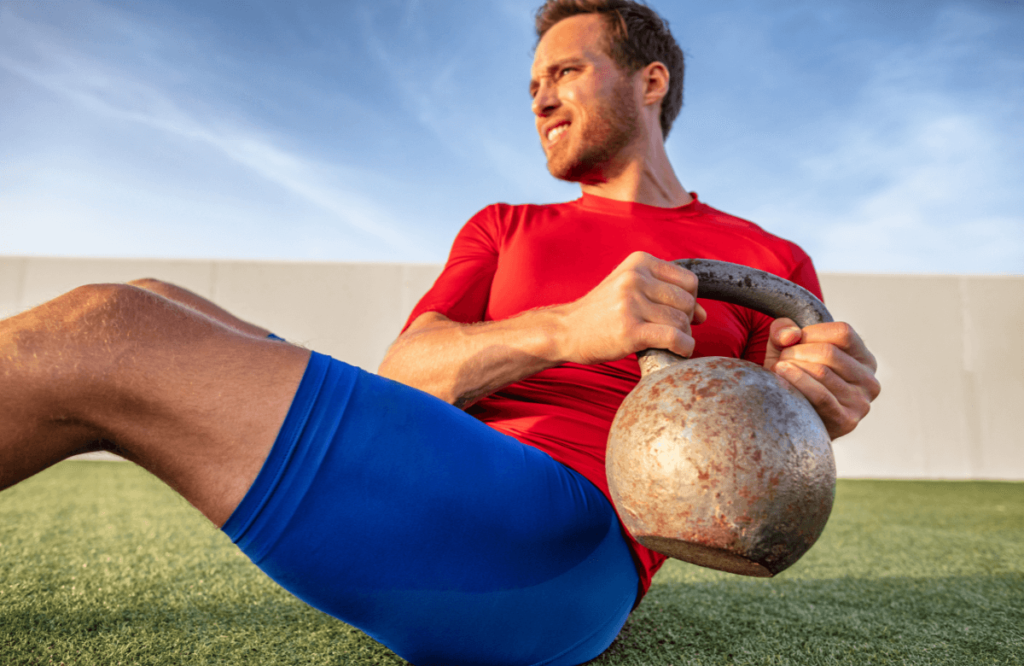KETTLEBELL ABS EXERCISE : THE COMPLETE GUIDE
The kettlebell to develop abs?
The kettlebell is a very versatile tool that allows you to develop, strengthen and tone your abs. The main exercises inkettlebell training for abs are as follows:
- Sit Up
- Lateral flexion with kettlebell
- Russian Twist / Rotation with kettlebell
- Turkish Get Up
- Kettlebell Goblet Squat
- Kettlebell Front Squat
- Kettlebell Suitcase Deadlift / Kettlebell Deadlift
- Kettlebell Swing
- Farmer Carry
- Front Rack Carry
First, we will look at the different roles of the abdominal muscles and the main muscles that make them up. Next, each exercise in the above list will be detailed. Finally, we’ll show you an example of a special abs session with a kettlebell.
The roles of the abdominal muscles
The abdominal girdle is made up of the following main muscles : rectus abdominis, internal oblique, external oblique, transverse and serratus abdominis. These muscle groups have a number of roles, including : trunk mobility and force transfer, as well as spinal protection and postural maintenance.
Protection of the spine and postural maintenance
The primary role of the abdominal strap is to stabilize and protect your spine and pelvis from shocks, explosive movements, etc. This is what is called sheathing, the ability of these muscles to stiffen up as much as possible to resist external actions. Your abdominal muscles must therefore be very strong, but you must still be able to move simultaneously ; in other words, the rigidity of your core muscles must not impede movement.
Trunk mobility and force transfer
In addition to providing protection and stability, the abdominal girdle also plays a role in force transfer : transmitting force from the lower limbs to the upper limbs and vice versa. Think of it as a focal point, a way station. In addition to being rigid, it must be powerful to allow the execution of complete and complex movements.

Best ab exercises with kettlebell
Kettlebell ab exercises can be divided into two categories :
- Exercises in which the abdominal muscles are the motors of movement and are therefore the muscles that are mainly worked : Bust flexions and rotations with kettlebells
- Exercises in which the abdominal muscles are not the driving force behind the movement but play a supporting, postural role : deadlifts, squats, deadlifts and lifts with kettlebells.
Bending and rotating the chest with a kettlebell
Bending and rotating the torso are movements that work on the mobility of the trunk. The muscles of the abdominal girdle are the motors of the movement, i.e. they carry out the action. These are therefore the exercises traditionally used in bodybuilding to build muscle mass in this area and ” tailler ” or ” dessiner ” the abs.
Sit Up / Kettlebell Torso Lift :
The chest press is probably the best known exercise for working the abs. It mainly solicits the rectus abdominis and the hip flexors. In its kettlebell version, it allows you to overload the abdominal muscles for a more intense muscle workout.
Be careful though, the kettlebell chest press is an advanced exercise for trained people. If you are a beginner, perform your sit-ups with your body weight only, without any additional load.
Execution :
The exercise is done lying on the back, knees bent and feet flat (it is also possible to block the feet, under a piece of furniture for example). The kettlebell rests on your chest and your hands hold the handle. From this position, raise your torso while keeping your feet and buttocks in contact with the floor until the kettlebell touches your thighs.
For muscle building purposes, the exercise can be performed in a slow and controlled manner to maximize muscle tension. And for an objective of development of the power of the abdominal strap, it will be rather carried out in a fast and explosive way.
Lateral flexion with kettlebell :
Contrary to what we regularly see, lateral bending is not performed with a kettlebell in each hand. If you do it this way, you negate much of the muscle work of the obliques. In fact, the second kettlebell placed in the other hand acts as a counterweight and thus greatly facilitates the ascent. For the purpose of maximum muscle tension, this execution is not appropriate.
In any case, always adapt the load to your level ! For beginners, it’s even possible to perform the movement without any weight at all for the first few stages, to learn how to feel the action of the muscles.
Execution :
Lateral bending with a kettlebell is therefore performed unilaterally, alternating one side then the other. Standing, feet flat, abs and glutes contracted : take a kettlebell in one hand, then bend your torso to the side of the kettlebell. Then, stand up straight. When you have completed your set, do the same on the other side.
Russian Twist / Rotation with kettlebell :
Like the chest press, the russian twist is a well-known movement for strengthening the abdominal muscles. This exercise involves the major muscle groups of the abdomen, such as the rectus, transversus and obliques. It is particularly interesting to work the rotation of the bust, which makes it a very functional exercise.
Execution :
This exercise is done sitting on the ground, legs bent and supported on the heels (it is also possible to keep the feet in the air to intensify the work of sheathing and balance). From this position, take a kettlebell in your hands and rotate your torso to one side and then to the other, touching the floor with the kettlebell each time.

Lifts, squats, deadlifts and carries with kettlebells
In this second type of exercise, the muscles of the abdominal belt are no longer the main actors of the movement. They have a role of postural maintenance, stabilization of the movement, sheathing. In this case, it is rather the deep abdominal muscles that are solicited.
Turkish Get Up / kettlebell lift :
The kettlebell lift is a basic exercise for developing strength and stability. Its origin would go back to the time of the ancient Turkish wrestlers. This is the foundation for overhead load control : shoulder stability and mobility, back engagement and, above all, postural strengthening.
That’s the point we’re interested in here : to support the load throughout the movement, the abdominal muscles are put to great use, making this a very interesting exercise for strengthening the abs.
The kettlebell lift is a complex exercise that requires a good learning curve. If you are not familiar with this movement, you should first perform it with a shoe placed on your closed fist. This technique allows you to learn the technique without using a load : your movement must be sufficiently stable and controlled to avoid knocking the shoe to the ground.
Kettlebell Goblet Squat :
Like the sit-up, the goblet squat with kettlebell activates the abs with a stabilizing and postural support role. Indeed, the kettlebell being placed in front, it is necessary to strongly contract the abdominal strap to maintain the chest straight throughout the movement.
Execution :
Take a kettlebell with both hands and lift it to chest level. Hold it at that level, then do squats. The difficulty of the exercise consists in the fact of strongly contracting the abs while maintaining the thoracic expansion (not rounding the upper back), which makes the goblet squat a very good exercise of postural correction.
Kettlebell Front Squat :
The front squat with kettlebells is similar to the goblet squat and has the same benefits. The squat is performed this time with two kettlebells (one in each hand).
Execution :
With the two kettlebells placed side by side on the floor, you will have to perform a clean or shoulder press to bring them into the rack position (kettlebells resting on the shoulders). From this position, perform your squats.
Kettlebell Suitcase Deadlift / Soulevé de terre avec kettlebell :
Since kettlebell lifts are hip and spine extension movements, the abs will not be the driving muscles as their role is more to flex the spine. However, the deep muscles will still be strongly solicited because, as with squats or lifts, they must stabilize and maintain the posture.
The deadlift can be performed one-handed with a single kettlebell, or two-handed with two kettlebells. The kettlebell(s) can be placed on the inside of the legs or on the outside. To develop the abdominal belt, prefer the one-handed variations.
One-handed lifts create an imbalance that has to be compensated for by a strong muscular contraction of the abdomen: the abdominal muscles are therefore put to greater use. And for a focus on the obliques, place the kettlebell on the outside of the legs instead. This variation is called the kettlebell suitcase deadlift.
Execution :
So place your kettlebell on the outside of your leg. Grab it and stand up straight with your arm extended. At the end of your set, switch sides.
Kettlebell Swing :
The kettlebell swing is probably the most popular kettlebell exercise. Like the deadlift, this is a hip and spine extension exercise. This time, however, it is done in a dynamic way with a swinging movement.
In its one-handed variant, there will be an important work of anti-rotation, very beneficial to tone and strengthen the abs. It is recommended to master the two-handed swing before attempting the one-handed swing.
Kettlebell Farmer Carry / Porté du fermier avec kettlebells :
Finally, the last type of kettlebell exercise involving the deep abdominal muscles is the lift: this involves moving around while carrying a load. Just like the deadlifts or squats, the abs have a stabilizing role for the spine.
The kettlebell farmer carry is very similar to the suitcase deadlift because the position is the same and so is the anti-flexion work. The load throws you off balance and you have to strain your abs to keep your posture straight.
Execution :
Place the kettlebell on the outside of your leg. Grab it, stand up straight with your arm outstretched, and walk a distance.
Kettlebell Front Rack Carry :
Here the starting position is the same as for the kettlebell front squat, and the muscular effort will also be similar.
Directed by :
Perform a clean or shoulder press to bring the kettlebells to your shoulders, then walk a distance.

Abs session with kettlebell
For an optimal and complete development of the abs, it is wise to mix exercises such as flexion, rotation and postural maintenance.
Here we give you an example of how to choose exercises and the number of sets and reps. To organize a specific abs session with kettlebell, you can select the following exercises:
- One deadlift (10 reps on each side) or one squat (3 sets of 10 reps)
- Sit up/front bend (3 sets of 10 repetitions)
- Lateral flexion (3 sets of 10 repetitions)
- The russian twist/rotation of the bust (3 sets of 20 repetitions)
- One get-up (3 sets of 10 reps) or one carry (3 steps of 20 meters)
The exercises are to be performed in this order. Indeed, the lifts and squats require a lot of energy and concentration to maintain a good posture, so it is advisable to perform them at the beginning of the session. You then move on to specific ab work : front flexion, side flexion and chest rotation. Lastly, you can add a deadlift or lift that requires less commitment than the relevé or squat, and which will act as a ” finisher ” for your abs.
Don’t forget to adapt the exercises to your level by selecting the appropriate weight for each one, even if it means doing them without load at first.
Other articles that might interest you:
- MMA physical preparation with kettlebell
- Tennis physical preparation with kettlebell
- Military training with kettlebell
- GPP for running with kettlebell
- WOD with kettlebell in CrossFit
- Bodybuilding with kettlebell
- Kettlebell exercises for women
- Kettlebell HIIT
- Kettlebell sport : all you need to know
- Skiing physical preparation with kettlebell
- Handball physical preparation with kettlebell
- Basketball physical preparation with kettlebell
- Rugby physical preparation with kettlebell
- Football physical preparation with kettlebell
Sources :

